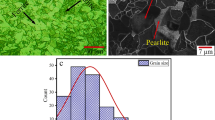Abstract
Activated metal inert gas (MIG) welding effectively improves penetration capability and weld bead geometry through precoating with activating flux on a specimen before MIG welding is a novel welding process. The geometry of welds varies considerably during the activated MIG welding process. A proposed approach that integrated the gray relational analysis (GRA) and fuzzy logic was employed to increase penetration and improve the geometry of welds. The multiple quality characteristics (QCs) of weld bead geometry that include penetration and depth-to-width ratio (DWR) of welds were solved using the GRA. Subsequently, a gray fuzzy reasoning grade (GFRG) was used to determine the weight ratio of mixed-component flux and the other welding conditions. The experimental results revealed that the proposed approach simultaneously improves the penetration and DWR of MIG butt-joint welds. Aluminum alloy butt-joint welds precoated with the mixed-component flux that consisted of 20% TiO2, 20% Fe2O3, and 60% Cr2O3 powder had more effective weld bead geometry. Additionally, the experimental results indicated that the Marangoni convection is the main mechanism for improving the penetration and geometry of activated MIG aluminum alloy welds.
Similar content being viewed by others
References
Zhang ZD, Kong XY (2012) Study on DC double metal inert gas (MIG) welding of magnesium alloy. Mater Manuf Process 27:462–466
Huang HY (2010) Effects of activating flux on the welded joint characteristics in gas metal arc welding. Mater Des 31:2488–2495
Lin HL, Yan JC (2014) Optimization of weld bead geometry in the activated GMA welding process via a grey-based Taguchi method. J Mech Sci Technol 28(8):3249–3254
Lin HL, Wang WK (2016) Effect of activating flux on the A356 and 6061 aluminum alloy GMA welds. Appl Mech Mater 835:161–165
Xu YL, Dong ZB, Wei YH, Yang CL (2007) Marangoni convection and weld shape variation in A-TIG welding process. Theor Appl Fract Mech 48:178–186
Tseng KH (2013) Development and application of oxide-based flux powder for tungsten inert gas welding of austenitic stainless steels. Powder Technol 233:72–79
Lin HL, Chou CP (2010) Optimization of the GTA welding process using combination of the Taguchi method and a neural-genetic approach. Mater Manuf Process 25:631–636
Lin HL, Wu TM (2012) Effects of activating flux on weld bead geometry of Inconel 718 alloy TIG welds. Mater Manuf Process 27:1457–1461
Sun JH, Fang YC, Hsueh BR (2012) Combining Taguchi with fuzzy method on extended optimal design of miniature zoom optics with liquid lens. Optik 123:1768–1774
Liu NM, Horng JT, Chiang KT (2009) The method of grey-fuzzy logic for optimizing multi-response problems during the manufacturing process: a case study of the light guide plate printing process. Int J Adv Manuf Technol 41:200–210
Aghakhani M, Ghaderi MR, Karami A, Derakhshan AA (2014) Combined effect of TiO2 nanoparticles and input welding parameters on the weld bead penetration in submerged arc welding process using fuzzy logic. Int J Adv Manuf Technol 70:63–72
Zadeh LH (1973) Outline of a new approach to the analysis of complex systems and decision processes. IEEE Trans Syst Man Cybern 3:28–44
Chiang TL, Su CT (2003) Optimization of the TQFP molding process using neuro-fuzzy-GA approach. Eur J Oper Res 147:156–164
Lin JL, Lin CL (2005) The use of grey-fuzzy logic for the optimization of the manufacturing process. J Mater Process Technol 160:9–15
Yang YS, Huang W (2012) A grey-fuzzy Taguchi approach for optimizing multi-objective properties of zirconium-containing diamond-like carbon coatings. Exp Syst Appl 39:743–750
Pattnaik S, Karunakar DB, Jha PK (2013) Multi-characteristic optimization of wax patterns in the investment casting process using grey-fuzzy logic. Int J Adv Manuf Technol 67:1577–1587
Leconte S, Paillard P, Saindrenan J (2006) Effect of fluxes containing oxides on tungsten inert gas welding process. Sci Technol Weld Join 11(1):43–47
Dong WC, Lu SP, Li DZ, Li YY (2011) GTAW liquid pool convections and the weld shape variations under helium gas shielding. Int J Heat Mass Transf 54:1420–1431
Limmaneevichitr C, Kou S (2000) Experiments to simulate effect of Marangoni convection on weld pool shape. Weld J 79(8):231s–237s
Huang Y, Fan D, Fan Q (2007) Study of mechanism of activating flux increasing weld penetration of AC A-TIG welding for aluminum alloy. Front Mech Eng China 2(4):442–447
Author information
Authors and Affiliations
Corresponding author
Rights and permissions
About this article
Cite this article
Lin, HL. Applying gray fuzzy logic to decide the weight ratio of activating flux during activated MIG aluminum alloy butt-joint welding. Int J Adv Manuf Technol 92, 471–479 (2017). https://doi.org/10.1007/s00170-017-0161-0
Received:
Accepted:
Published:
Issue Date:
DOI: https://doi.org/10.1007/s00170-017-0161-0




